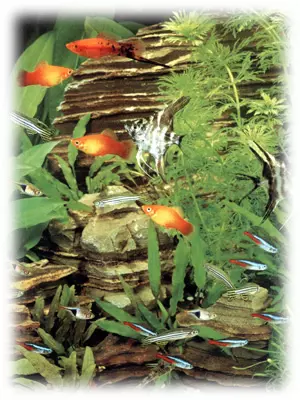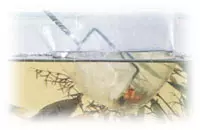The community aquarium represents a huge challenge when taken seriously. Achieving balance between different species of fish and plants within an aquarium is a really complex process. In the assembly of a planted community aquarium, we can say that there is a triple crown desired by every amateur :
While there are many factors to consider together to build an aquarium, there is no single strict formula with steps to follow. Of course, it is vitally important to mention each of these factors to be evaluated. This explanation is only intended to be a reference guide, especially for those who are just entering the world of aquariophilia.
; Choice of fish: Just decide what fish you like. Then you will need to take into account the characteristics of each of them. If there are incompatibilities, you will surely see what is the ideal combination, between the desired fish that adapt to coexistence between them and that need similar water characteristics. Water factors such as pH, hardness (dH) and temperature should be considered. Eating habits also count.
; The decoration of the aquarium. : It will depend entirely on the needs of the fish. For example, if you choose brackish water fish (they live encounters between river and sea water), you will need to include sea salt and some Toba rock to harden the water. This results in a reduction of possible plants for this aquarium. A few will develop well under those conditions. Fish from African lakes (African Cichlids ) devastate plantations, so you can only decorate them with rocks. Consider also lighting, usually more daily hours in planted aquariums.
; Water filtering: Some fish need very high oxygen levels, so they will require aerator and filter mandatory. But in some cases, those who decide to plant the aquarium and devote resources to plant growth prefer to have fewer fish but avoid filters or aerators. This prevents the loss of carbon dioxide, so important for the vital processes of plants.
; Aquarium size: While it is true that the larger the better, there are important limitations to highlight. It is NEVER convenient that the height of the fish tank exceeds 60 cm. It brings a variety of problems. The first is the pressure exerted by water. Some fish may experience problems. Second drawback, the high pressure will impose the need to use glasses more than 1 cm thick. It'll be too heavy. Thirdly, cleaning and manipulating elements of the bottom of the fish tank will be too uncomfortable.
In order not to overpopulate and have problems with oxygen and water filtering, we can establish as a general rule that 1.5 litres of water are required for each cm of fish. But be advised, as some fish like Dis ks need much more, especially if you want to play them . Keep in mind that the larger the area of the aquarium surface, the more oxygen exchange there is between air and water. More area, more oxygen the aquarium will have.
Knowing that we must evaluate the points described above, now comes the interesting part. How to proceed when assembling the aquarium. The installation of the elements that make up an aquarium. Let's start with the location of the aquarium in your home. Look for a quiet place, away from windows and drafts. Always avoid that the aquarium receives the sun's rays directly. These would generate a colossal amount of algae. If it's close to a tap, it's better. A valid recommendation is to move the aquarium (always empty) between two people. It's not about strength, it's about security. Be sure to place it on a level, fluffy surface, such as a telgopor or polyfan plate. It will avoid cracks.
Absolutely everything that goes to the aquarium should be washed with water WITHOUT soap or any kind of cleaning product. First we will clean the glass from the aquarium, as they usually accumulate dust in the shop where we buy it. It is convenient to buy sponges and rags that we will use to maintain our fish tank only. We will clean the biological filtration plates and other elements such as diffuser peaks, hoses, etc. To know how to proceed with rocks and logs click here. Gravel will need to be passed through boiling water a couple of times. Later, rinse it with water at room temperature in a colander. From there straight to the aquarium, over the filter plates.
An effective method of planning the location of the elements in the aquarium is to generate a sketch. Measure filter sizes and other items. Think and then draw the distribution of rocks, trunks and plants. Make a list containing everything you need to place in the fish tank. Locate the heater in an area that has good water circulation. Ideally, place it with suction cups on the back wall, in an oblique position. Put a thermometer on the opposite end of the heater, although I personally recommend putting one on each corner of the aquarium, to ensure that the temperature is homogeneous.
Place the biological filtration plates, hoses and diffuser peaks of the aerator. Locate the largest rocks, and then gravel . If you do not have plants, a layer of 3 cm is sufficient. Otherwise, 6 cm will allow the plants to be buried firmly. Remember this clarification, but keep in mind that plants are not included in the assembly, you will have to wait 3 to 4 days. Have the heater (unplugged) and thermometers as explained in the previous paragraph. Place trunks and other decorative objects such as sunken boats, columns, etc .Fill the aquarium with water, condiction with chemicals recommended by a specialist store. Use anti-chlorine. After full of water, activate the heater, aerator, and install and activate the filter . Set the heater thermostat to the desired temperature. Check the correct operation of the devices for 4 days. Stabilize pH and dH to appropriate levels for the desired fish and plants. After 4 days, carefully acquire and place the plants . * Be patient, ideally wait 2 to 4 weeks to include a few fish. If you have plants or used cultures of bacteria for the maturation of the aquarium, 2 weeks will be enough, otherwise 36 days will last the nitrogen cycle. After that period, ammonium levels in the water are tolerable by fish.

© Adrián Blanco 2005 / 2010 — No full or partial reproduction of text and/or images without explicit written consent of the author.